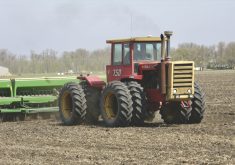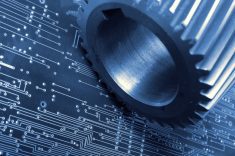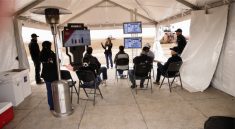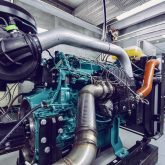Why January 4th? Well, John Deere, the world’s biggest ag equipment brand, announced that day it is building a fully autonomous 8R tractor for the North American marketplace this year.
This is a really big deal.
“Autonomy is no longer just a concept or a demo,” said Jahmy Hindman, chief technology officer at Deere. “It’s real.”
Read Also

Farmland values: assumptions and realities
Where farmland values are headed and what decisions farmers should make
Yes, we’ve seen a smattering of other autonomous machines in the last couple of years, but on a small scale. Nothing so far comes close to the impact the autonomous 8R Deere is bound to make on the industry.
Other major brands have shown concept autonomous tractors but shied away from commercial release, mainly because of the risk of civil liability or the need for more R&D.
That created a gap for a few smaller firms and tech startups that led the way in a pattern that is becoming familiar. A California-based startup, Bear Flag Robotics, got to the market first. Then, last summer, Deere bought Bear Flag.
As she spoke to reporters, Bear Flag co-founder and COO Aubrey Donnellan was optimistic the technology was ready for a much broader market.
“Get excited. It’s going to be available very soon,” she said.
This will make Deere the first major brand to offer an autonomous production tractor on a broad scale. The initial launch is focused on automated tillage work, just as Bear Flag had done, but Deere execs say the range of operations will grow significantly.
“John Deere autonomous farming equipment will also execute other jobs that farmers need to do throughout the year,” said Deanna Kovar, vice-president of Deere’s production and precision ag business.
In the field, farmers will be able to let the 8R loose to work on its own, unsupervised.
“When the tractor is running autonomously, farmers can monitor its progress remotely on a smartphone, tablet or computer,” Kovar said. “They could be watching from inside the cab of another John Deere piece of equipment in a nearby field, from their office or somewhere else entirely with their family. Not only are they tracking where the tractor is, they’re tracking the quality of job it’s doing and if any adjustments need to be made.”
Deere has owned the pole position on developing technology in the ag equipment world in the last decade or so. It led on telematics and forced other brands to play catch-up. Now, it’s bound to repeat that with autonomous tractors.
And it heralds the arrival of a new major milestone in equipment the same way the introduction of hydraulics and then electrical advancements did in previous generations. It’s hard to overstate the significance of it.
What makes autonomy possible is the current state of AI (artificial intelligence).
What exactly is AI? According to the Oxford dictionary it’s “The theory and development of computer systems able to perform tasks normally requiring human intelligence, such as visual perception, speech recognition, decision-making and translation between languages.”
It’s that ability of a computer to perceive its environment and make decisions that enables autonomous tractors.
Existing AI technology is becoming increasingly capable of learning and making decisions. And Deere’s engineers have been busy providing information to the “brain” of the autonomous system that allows the 8R to learn from images of farm fields. That library of reference knowledge is then used to help it make decisions based on what the tractor sees in front of it through its six pairs of cameras.
“The image the cameras capture gets passed into the deep neural networks that are trained on hundreds of thousands of images,” explained Willy Pell, Deere’s vice-president of autonomy and new ventures. “The neural networks classify these pixels with amazing speed — in about 100 milliseconds. Then, depending on the objects they detect, the machine either continues or it stops.”
Building what Deere calls “a production-worthy vision system” has required a world-class machine-learning research team and many hard fought innovations.
And it’s continually getting better, says Pell. “In addition to the more than 50 million images we’ve collected from farms all over the U.S. in the last three years, we’re constantly feeding it new information and new images. And the training process rewards it for making correct decisions and penalizes it for making incorrect ones.”
Yes, you heard the right. These robots respond to rewards. After all, they work for us!
It has actually been an incredibly challenging job. What makes autonomy on the farm so difficult, Pell said, are “all the rare, difficult-to-foresee events for which we have no training data. For example, a billboard falls in a field … to handle these types of situations, we built an anomaly detection system which recognizes nominal images of sky, ground and trees. When it encounters new objects that don’t fit within the standard class of objects, the machine just stops. Using this technology, we’re able to achieve a very high degree of safety and performance, despite situations where the tractor sees a completely new or random object.”
Although the autonomous 8R is a breakthrough machine, it is just one more application where AI is already pushing ag equipment design into an entirely new future. At Deere alone, AI systems have already been used in other applications, like Combine Advisor that allows a Deere combine to constantly re-evaluate its operating settings for maximum threshing, and See and Spray Select that allows a sprayer to detect plants in a field and spray only when needed.
But AI isn’t unique to Deere machines, it’s popping up nearly everywhere. It’s what Klaus Schwab, founder of the World Economic Forum, has coined as the “fourth industrial revolution.”
“I still get goosebumps,” said Kovar. “Autonomy isn’t a convenience on the farm, it’s a necessity today and into the future … What’s unique about this tractor (the 8R) isn’t just the technology. It’s that it’s working today and ready for production.”
















